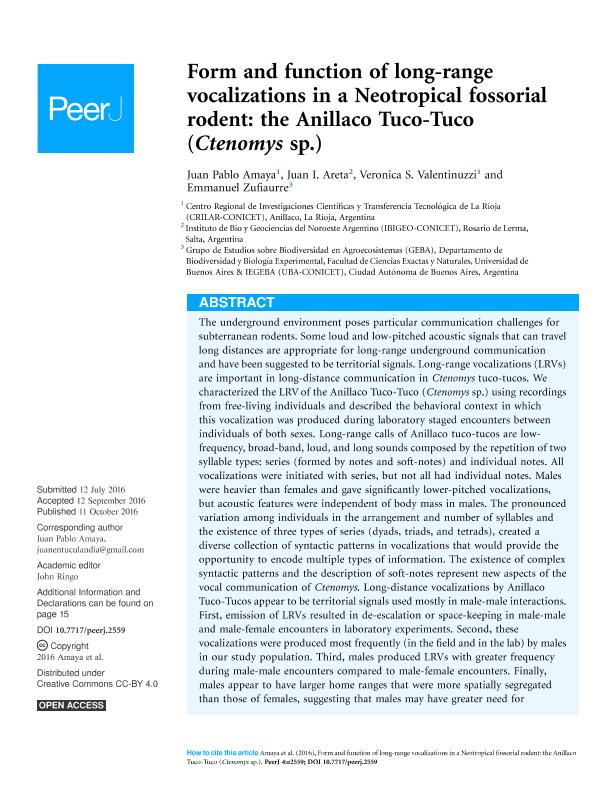Mostrar el registro sencillo del ítem
dc.contributor.author
Amaya, Juan Pablo

dc.contributor.author
Areta, Juan Ignacio

dc.contributor.author
Valentinuzzi, Verónica Sandra

dc.contributor.author
Zufiaurre, Emmanuel

dc.date.available
2018-06-21T20:26:37Z
dc.date.issued
2016-10-11
dc.identifier.citation
Amaya, Juan Pablo; Areta, Juan Ignacio; Valentinuzzi, Verónica Sandra; Zufiaurre, Emmanuel; Form and function of long-range vocalizations in a Neotropical fossorial rodent: The Anillaco Tuco-Tuco (Ctenomys sp.); PeerJ Inc.; PeerJ; 10; 11-10-2016
dc.identifier.issn
2167-8359
dc.identifier.uri
http://hdl.handle.net/11336/49596
dc.description.abstract
The underground environment poses particular communication challenges for subterranean rodents. Some loud and low-pitched acoustic signals that can travel long distances are appropriate for long-range underground communication and have been suggested to be territorial signals. Long-range vocalizations (LRVs) are important in long-distance communication in Ctenomys tuco-tucos. We characterized the LRV of the Anillaco Tuco-Tuco (Ctenomys sp.) using recordings from free-living individuals and described the behavioral context in which this vocalization was produced during laboratory staged encounters between individuals of both sexes. Long-range calls of Anillaco tuco-tucos are lowfrequency, broad-band, loud, and long sounds composed by the repetition of two syllable types: series (formed by notes and soft-notes) and individual notes. All vocalizations were initiated with series, but not all had individual notes. Males were heavier than females and gave significantly lower-pitched vocalizations, but acoustic features were independent of body mass in males. The pronounced variation among individuals in the arrangement and number of syllables and the existence of three types of series (dyads, triads, and tetrads), created a diverse collection of syntactic patterns in vocalizations that would provide the opportunity to encode multiple types of information. The existence of complex syntactic patterns and the description of soft-notes represent new aspects of the vocal communication of Ctenomys. Long-distance vocalizations by Anillaco Tuco-Tucos appear to be territorial signals used mostly in male-male interactions. First, emission of LRVs resulted in de-escalation or space-keeping in male-male and male-female encounters in laboratory experiments. Second, these vocalizations were produced most frequently (in the field and in the lab) by males in our study population. Third, males produced LRVs with greater frequency during male-male encounters compared to male-female encounters. Finally, males appear to have larger home ranges that were more spatially segregated than those of females, suggesting that males may have greater need for long-distance signals that advertise their presence. Due to their apparent rarity, the function and acoustic features of LRV in female tuco-tucos remain inadequately known.
dc.format
application/pdf
dc.language.iso
eng
dc.publisher
PeerJ Inc.
dc.rights
info:eu-repo/semantics/openAccess
dc.rights.uri
https://creativecommons.org/licenses/by-nc-sa/2.5/ar/
dc.subject
Ctenomyidae
dc.subject
Fossorial Rodents
dc.subject
Underground Bioacustics
dc.subject
Vocal Communication
dc.subject.classification
Otras Ciencias Biológicas

dc.subject.classification
Ciencias Biológicas

dc.subject.classification
CIENCIAS NATURALES Y EXACTAS

dc.title
Form and function of long-range vocalizations in a Neotropical fossorial rodent: The Anillaco Tuco-Tuco (Ctenomys sp.)
dc.type
info:eu-repo/semantics/article
dc.type
info:ar-repo/semantics/artículo
dc.type
info:eu-repo/semantics/publishedVersion
dc.date.updated
2018-05-23T13:32:33Z
dc.journal.number
10
dc.journal.pais
Reino Unido

dc.journal.ciudad
Londres
dc.description.fil
Fil: Amaya, Juan Pablo. Consejo Nacional de Investigaciones Científicas y Técnicas. Centro Regional de Investigaciones Científicas y Transferencia Tecnológica de La Rioja. - Universidad Nacional de La Rioja. Centro Regional de Investigaciones Científicas y Transferencia Tecnológica de La Rioja. - Universidad Nacional de Catamarca. Centro Regional de Investigaciones Científicas y Transferencia Tecnológica de La Rioja. - Secretaría de Industria y Minería. Servicio Geológico Minero Argentino. Centro Regional de Investigaciones Científicas y Transferencia Tecnológica de La Rioja. - Provincia de La Rioja. Centro Regional de Investigaciones Científicas y Transferencia Tecnológica de La Rioja; Argentina
dc.description.fil
Fil: Areta, Juan Ignacio. Consejo Nacional de Investigaciones Científicas y Técnicas. Centro Científico Tecnológico Conicet - Salta. Instituto de Bio y Geociencias del NOA. Universidad Nacional de Salta. Facultad de Ciencias Naturales. Museo de Ciencias Naturales. Instituto de Bio y Geociencias del NOA; Argentina
dc.description.fil
Fil: Valentinuzzi, Verónica Sandra. Consejo Nacional de Investigaciones Científicas y Técnicas. Centro Regional de Investigaciones Científicas y Transferencia Tecnológica de La Rioja ; Argentina
dc.description.fil
Fil: Zufiaurre, Emmanuel. Universidad de Buenos Aires. Facultad de Ciencias Exactas y Naturales. Departamento de Biodiversidad y Biología Experimental. Grupo de Estudios sobre Biodiversidad en Agroecosistemas; Argentina. Consejo Nacional de Investigaciones Científicas y Técnicas; Argentina
dc.journal.title
PeerJ
dc.relation.alternativeid
info:eu-repo/semantics/altIdentifier/url/https://peerj.com/articles/2559/
dc.relation.alternativeid
info:eu-repo/semantics/altIdentifier/doi/http://dx.doi.org/10.7717/peerj.2559
Archivos asociados
